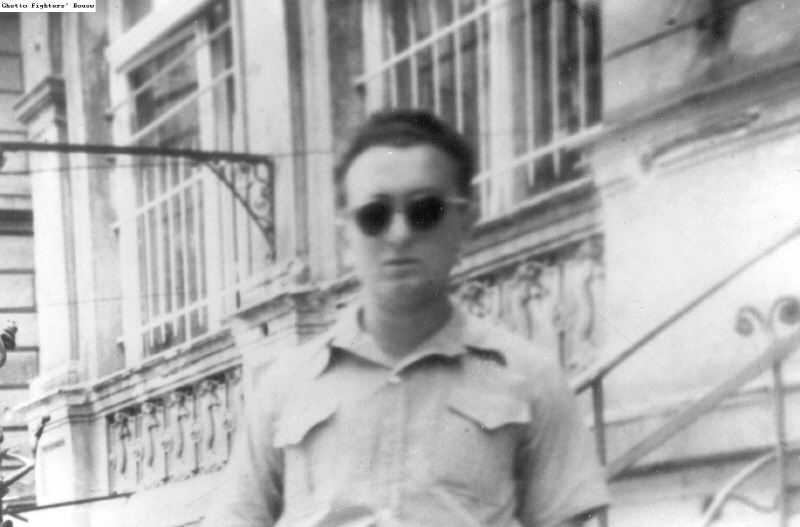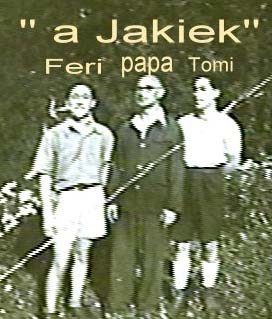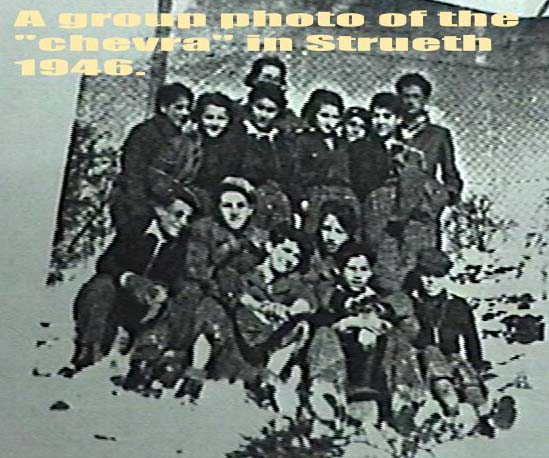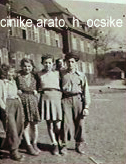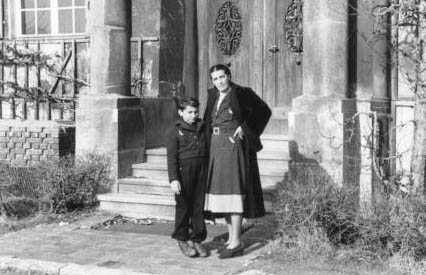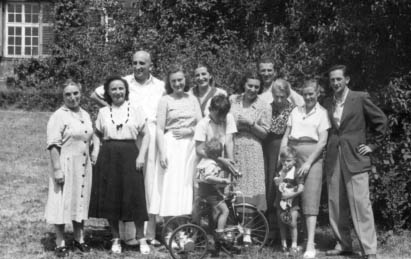DP Camp of Children in the sanatorium "Strüth / Strueth by Ansbach"
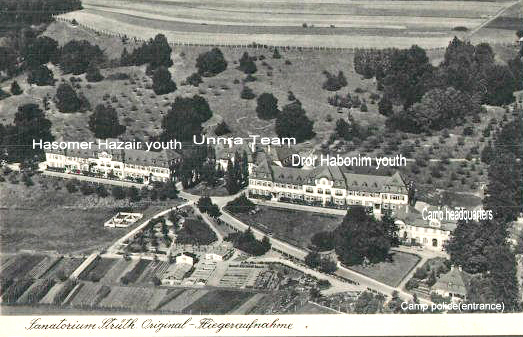 On the left is the sanatorium Strueth, taken from air in the year of 1939.
On the left is the sanatorium Strueth, taken from air in the year of 1939.
The remarks on it added by me to make it relevant for us.
On the right is a picture of the place, as it is now. This is a commercial advertisement of the "Rangau klinik in Strut by Ansbach". It didn't change much from 58 years ago. The two main buildings housed about 300 children. In the first building, were the children belonging to the Dror Habonim, Zionist movement, and in the second the children belonging to the "Shomer Hazair, Zionist organization.

How we became Zionist and decided to build a new homeland. By Rafi Ben Zur (nagy Jaki), Haifa Israel, April 2005.
Our story begins when that ghetto Budapest was freed by the Russian troops, on 18th of January 1945. I was 14, my brother 13, totally alone, in the middle of chaos, not knowing what to do. We followed bigger children, running away from the burning ghetto while the fighting was still going on. Later on, we were collected by the Dror Habonim zionist movement, which was in it's early stage of organization. They were looking for lonely, hungry children, lost in the big city with no one to feed them. At that time, we knew nothing of Zionizm or of Palestine for that matter, and Zionizm meant to us food and shelter, someone to wash you, and to give you clothes and shoes. The organization took us to the southern part of Hungary, fed us until we became human beings again (we were only skeletons after the war), and they started to educate us about Zionizm and Palestine.
Our father came home from his forced labour brigade, took us home, and tried to rebuild what left of our family. It was mission impossible. Everything arround reminded us of the past. The humiliation, discrimination, the arrow cross atrocities, the hatred and the killing. We wanted to start a new life, in a new homeland, built by us, where we could live as free people and are able to defend ourselves. This strong will led us back to the zionist movement and ultimatively to Palestine (later on Israel).
On December 1945, eleven months after our escape from ghetto Budapest, we were on the move again, this time to Germany. This Germany was so much different from the one we suffered from. This Germany was burned down to the foundation. It was a defeated country with a completely demoralized people.
We were brought to the sanatorium Strueth, about 4 kilometer away from a little Bavarian town, called Ansbach. This children's DP camp was well organized by the UNRRA. A team of American soldiers, with a by local professional staff, ran the camp efficiently.
In this children's camp, we were occupied by all kind of activities to prepare ourselves for the life in a kibuz in Erez, Israel (Palestine). We built roads, we milked cows, we did all the cleaning jobs, in short, we learned to respect work itself. We have started to learn the basic of the Hebrew language, combined with general studies (by professional teachers brought from Erez, Israel).
We had to wait about a whole year until our turn came to join Aliya Bet, in Southern France. The story of our Aliya Bet, you could read about in the chapter The illegal immigration. Author, Rafi Ben Zur, at the age of 18.
Olga, Thank you for what you are doing! ben zur rafael / Haifa, Israel, email: rafa_el@012.net.il
Here are some more photos:
I found the original picture of the dp camp Strueth / Strüth, and several pictures taken of the children belonging to the "Dror habonim", and to the "Hasomer" movements. I also found the description of our "Aliya Beth" from France en route to Israel (Palestine at the time). This is the building that housed 159 "Dror Habonim" children arrived from Hungary.
The next picture is of Eli Schlomovich (eli gamarti), He was a most important leader of the "Bricha" in Hungary, and an important figure in the survival of the Hungarian Jewish orphans. He brought the children of Dror Habonim, into the children Dp camp in Strueth.
Herta Goren (Schwarz), and her brother Amikam Schwarz. Taken in Strueth in the year of 1946. Herta was a guide and instructor for the children of Dror Habonim.
Many people from all over the world try to help by sending me photos to add to the site. I am sending you 3 pictures, asking your help to decorate the existing site. Respectfully, Rafi Ben Zur.
The picture of "Jaki Bacsi", posing in front of the main building of the dpcamp. He was responsible for the security of those residing inside the camp. We could sleep well, because no one could come in or to leave the camp without his consent.
Jaki bacsi died in Haifa, at the age of 83.
Jaki Bacsi with two of his sons. They both are residents of Haifa, Israel. Both sons were passengers of the illegal aliya ship "Lanegev", reaching the shores of Palestine on 9th of February 1947, captured by the British Navy and deported to Cyprus (see link below).
Illegal immigration to Palestine story by by Shimon Kaufman, Los Angeles, 1958
2/3/05 Dear Olga,
Thanks for the quick reply. Here are some of my experiences at Strüth. With my family, I stayed in the DP camp known variously as Strut, Struet, Strueth and Strüth (near Ansbach, in Bavaria [Bayern] Germany) from late 1949 to May 1950. Confusion about this location seems to stem from how the German umlaut of the "u" (ü, ue) is written, and from the existence of other similarly-spelled places elsewhere in Germany.
Apparently this facility had been a tuberculosis sanitorium before WW II. One of the mainstays of treatment of TB at that time was fresh mountain air. During the war, it was used as a German military headquarters, and after the war it had been used as an American military facility, then as a camp for children on their way to Palestine-Israel around 1947-1948, and then as a camp for immigrants to the USA around 1949-1950. In the last capacity, Strüth was connected with UNRA and IRO, which helped me get to the USA, but I do not know when and how this use of this facility ended.
Today again it contains a medical facility (Rangau Klinik) and it appears to have grown enough to merit mention in German real estate web sites, linked to the region of Ansbach. It appears that Ansbach has 'swallowed' this place.
When I stayed there, it was a remarkably pleasant place, in part because of its scenic location and, more importantly, because it offered tremendous relief for my parents after the war. Though I was about 9 years old then, it was clear to me that the occupants, all Holocaust and WW II Survivors, to the best of my recollection, enjoyed a degree of freedom, prosperity and personal safety that had eluded them for many years.
One of the other occupants was my uncle, who acted in some administrative and/or advisory capacity in cooperation with IRO and the US Army. (Apparently he held this position in part because he spoke some English.) For example, we had access to cars (including a US Army Jeep; see my photos), a driver, privileges to see American movies screened in Ansbach for US soldiers (which constituted my first exposure to American English), and access to reasonably good food, etc. We were able to keep pets. We were able to tour southern Germany and Switzerland.
My mother and I posed in front of the main entry to the building. Please notice the ill-fitting clothing and state of disrepair of the building, though I doubt we cared!
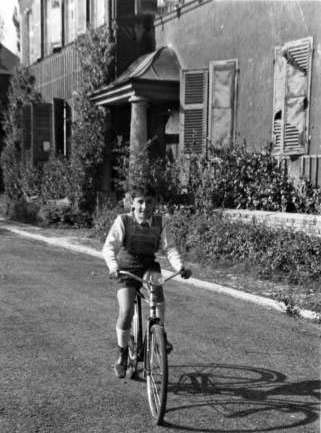 The building in the above picture contained a living/dining room and kitchen downstairs. I recall eating there, and I recall my parents playing cards there. Bedrooms and bathrooms were on the second floor, and I had my own room. I also had a bicycle (pictured) and played with other children there. The grounds were fairly large, so that it was a long hike or bike ride to the other end, and the entire facility was fenced in.
The building in the above picture contained a living/dining room and kitchen downstairs. I recall eating there, and I recall my parents playing cards there. Bedrooms and bathrooms were on the second floor, and I had my own room. I also had a bicycle (pictured) and played with other children there. The grounds were fairly large, so that it was a long hike or bike ride to the other end, and the entire facility was fenced in.
The "happy group" picture is quite remarkable because every one is a Holocaust survivor, and everyone migrated to the U.S. in 1950. Please notice the broad smiles! Our nightmare was over!! By the location of the trees I think that the background is the side of the first building. One of the adults in the group picture is Erna F. Rubinstein, who wrote a book, "The Survivor In Us All, Four Young Sisters In The Holocaust," in which she mentions Strueth. Another of her sisters is also in that picture. Later, the Rubensteins lived near us in Syracuse, NY., and we often reminisced about our experiences in Germany. However, except for the youngest child, I believe that I am the only still-living member of that group.
The Jeep, courtesy of the U.S. Army, is parked along the front, obviously at the corner, though I do not know which of the two buildings is in this picture. (The older child is me.)That is also me on the bicycle. First of all, it means that we could afford a bike. But note the condition of the shrubbery and pieces of black-out material still on the windows.
I just made a donation to your efforts. Regards,Louis Jagerman MD / USA, born Ludwik

